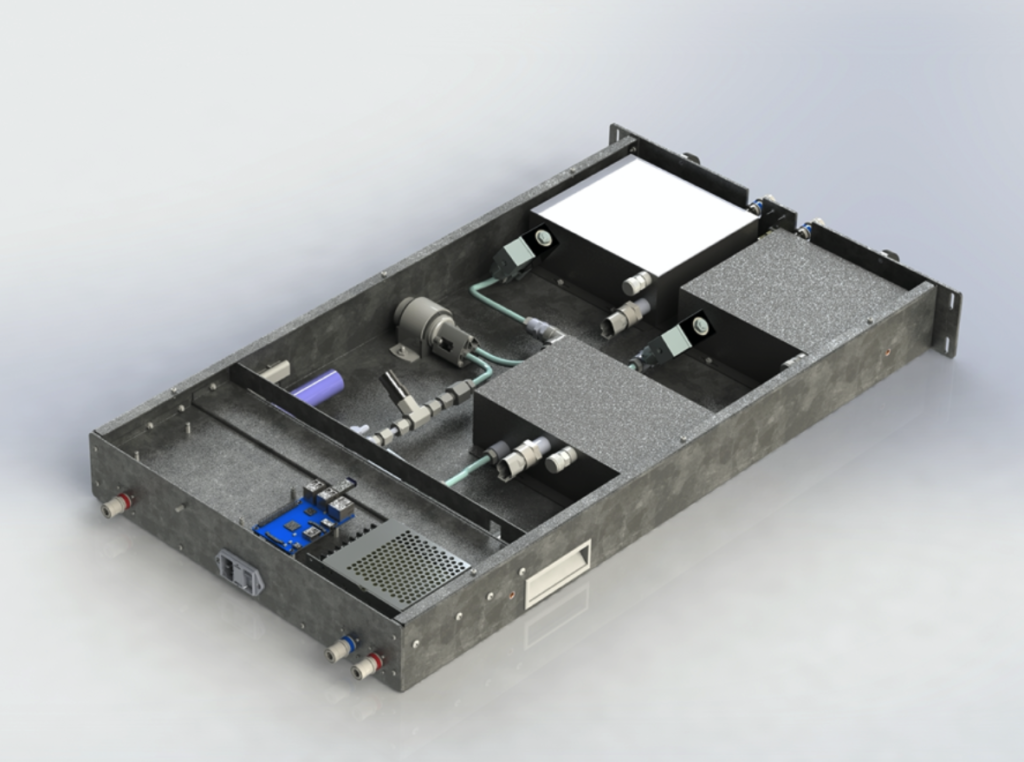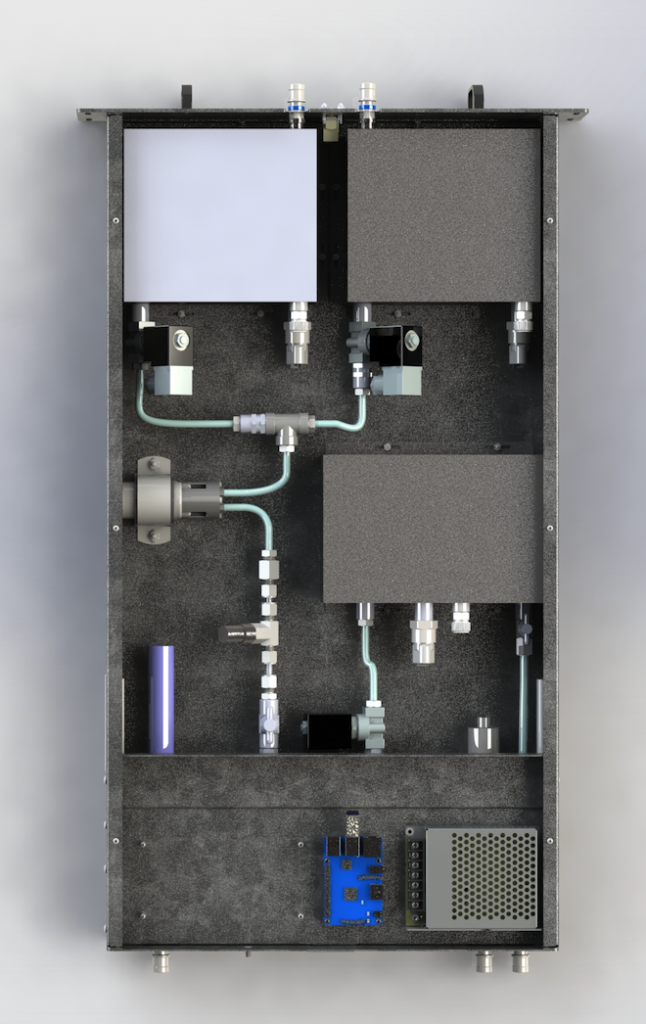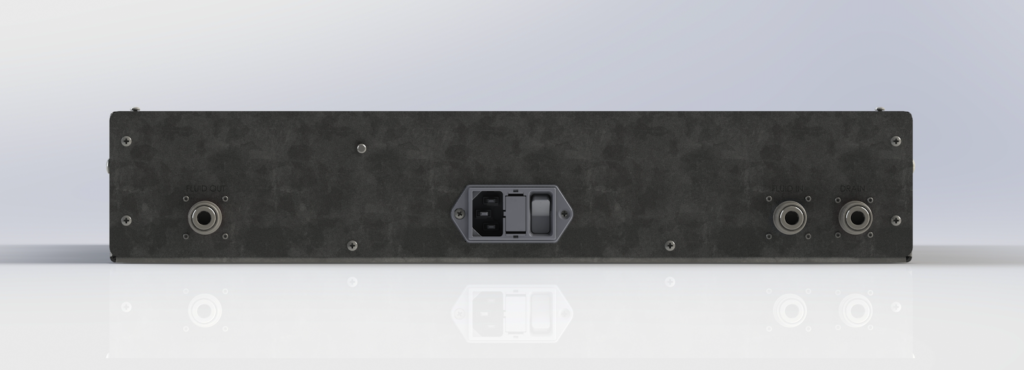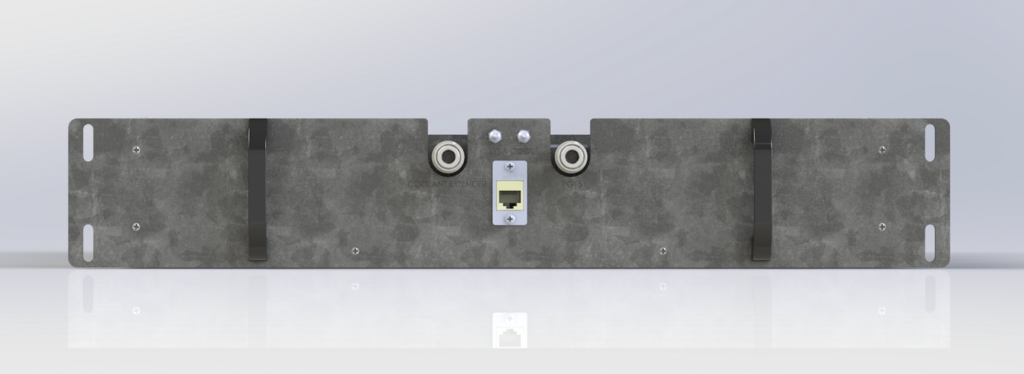Project Category: Energy Engineering
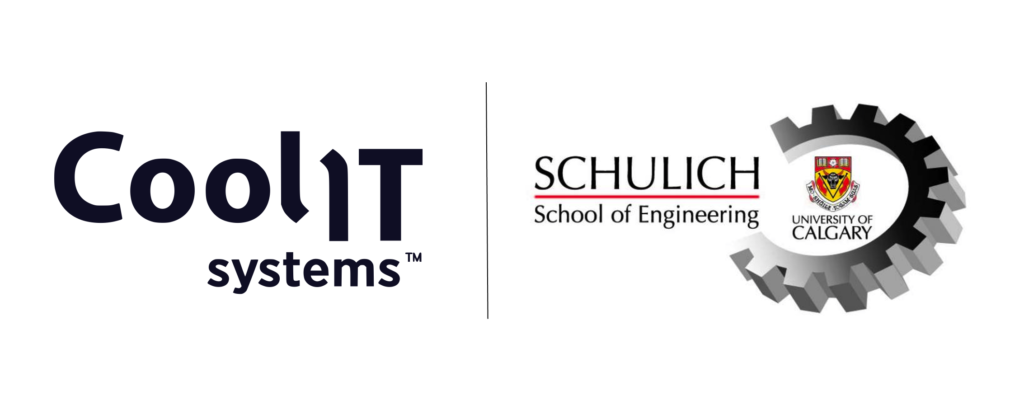
Join Our Presentation
The team is available on this zoom link on April 13 from 10 am to 12:30 pm
Our Project
Liquid cooling is becoming the preferred method of cooling large data centers and server rooms because it is more efficient and can remove more heat than traditional air-cooled systems. The project sponsor, CoolIT, designs and manufactures liquid cooling solutions to replace traditional air-cooled systems. These systems work by flowing coolant through tubes within server racks where heat is absorbed. The warm fluid is then brought to a heat exchanger that cools the liquid so it can be sent back into the system and repeat the process.
The coolant is specifically engineered for each application and must be kept in pristine condition free of contaminants and within its desired parameters to effectively dissipate heat from the electronics. The coolant requires maintenance to remain effective, currently this is done manually which requires additional resources. CoolIT has been monitoring the coolant within their systems manually for years, samples are collected on specific time intervals and are tested to evaluate various parameters of the coolant. If the coolant is not healthy 4% of the fluid is replaced with a “Coolant Extender” and is left until the next inspection. This process is tedious, time consuming and inefficient. CoolIT believes there is a better solution to address coolant maintenance and monitoring which is why they have partnered with the University of Calgary to address this issue. The project problem statement is as follows:
The primary objective of this capstone project is to design and develop a coolant monitoring system to manage coolant health in real time. This must be done in a cost-effective manner while ensuring accurate results and being practical in real-world scenarios.
The solution to this statement is being labelled as the “Coolant Health Management System” or CHMS. This product will have the ability to keep the criteria within an acceptable range without the need for human intervention or system downtime for coolant sampling. The CHMS will monitor and correct system coolant in real time and be able to mount directly into CoolIT’s existing systems. This system will not eliminate the need for in-person coolant testing as a complete chemical analysis is required but drastically decrease the frequency of manual maintenance.
Our Team

Adam Scoville
Energy Engineering Student & Mechanical Engineering Technologist

Keaton Jorginson
Energy Engineering Student & Mechanical Engineering Technologist

Brad Link
Energy Engineering Student & Mechanical Engineering Technologist

Jordan Stewart
Energy Engineering Student & Mechanical Engineering Technologist

Riley Foote
Energy Engineering Student & Mechanical Engineering Technologist

Steve Dale
Energy Engineering Student & Mechanical Engineering Technologist
Coolant Health Monitoring System
Design
The CHMS is a system that will be directly integrated into existing CoolIT liquid cooling systems. The CHMS will be able to monitor coolant health in real time and correct any imbalances within coolant health. The two parameters that are most vital in monitoring coolant health are pH and water content. A lower pH (higher acidity) will cause the coolant to promote corrosion and degrade the rubber hoses within the system. This could cause leaks in the coolant stream decreasing effectiveness and putting electrical components at risk of damage. Because the coolant consists primarily of water, monitoring the quantity in the system is important as water content directly affects how the coolant performs. High temperatures within the system cause water to evaporate, this results in a high concentration of other coolant compounds and a decreased overall fluid volume. In some cases, between 2-12L of water can be lost per year.
The pH will be monitored through a probe and “Coolant Extender” will be injected into the system to correct pH levels. Water content will be monitored by a conductivity sensor and a dilute coolant (PG-15) will be injected to replace water losses. Fluids will be held within their own reservoirs and will be driven by a single pump with respective solenoid valves. A waste tank will be used to drain a precise amount of existing fluid to ensure a correct mass flow balance. All components are to be controlled by a Raspberry Pi 2B through an external IO board.
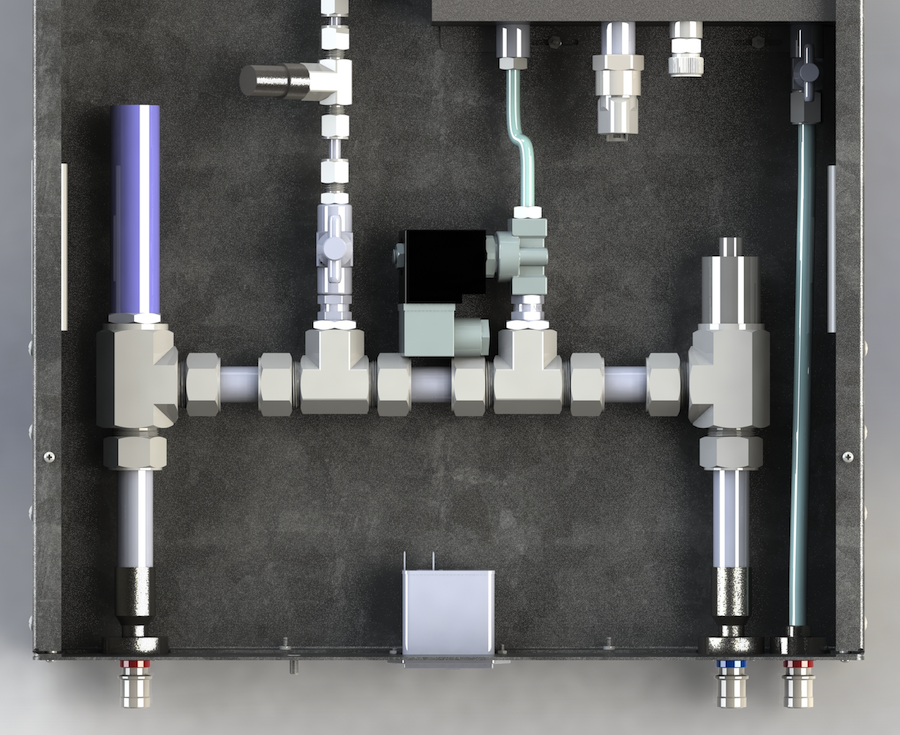
Innovation
Competitors for this type of liquid cooling units include companies like Fujitsu, Asetek, and Chilldyne. All three competitors allow for monitoring of coolant, but only to the extent of standard operating parameters such as temperature, pressure, and flow rate. Chilldyne, who targets HVAC clients more so than computers and servers, offers a very large, 24″ x 36″ x 72″, unit to distribute and monitor coolant with these parameters, forcing clients to install an entire new CDU in order to be able to monitor these parameters. Asetek is another competitor with a smaller rack sized CDU system, but their monitoring is also no more in depth than the typical operating parameters or previous CoolIT units. Fujitsu has a CDU module that can be implemented into a rack in a similar fashion to the rack size CDU’s that CoolIT offers. Fujitsu CDU’s include monitoring for pressure, flow rate, temperature, leak, and level. This is similar to CoolIT’s CDU’s, however CoolIT does not consider this a “monitoring” unit as those are just parameters typically required for normal operation of the coolant systems. The Fujitsu unit is better than some other competitors as it has a self-incorporated reservoir to top up the coolant levels when the level is detected to be low. However, the Fujitsu system does not implement real time monitoring of the actual coolant properties, i.e. pH and water/glycol content. That’s where the CHMS comes into play, CoolIT wanted to get a step ahead of any of their other competitors. They wanted to incorporate a rack sized monitoring unit to be implemented as green or brown field for their customers. They wanted to replace or reduce standard maintenance and sampling intervals with an automated system that will utilize additives in order to extend the life of the coolant where necessary. This would allow for remote monitoring and maintenance to be performed around the globe and CoolIT can even give their customers a heads up when the data shows a deterioration of the coolant and take preventive measures to mitigate any performance losses or damage.
Effectiveness
The Coolant Health Management System is a simple yet effective design for monitoring basic coolant health within CoolIT’s systems. Our solution involves the use of a pH and conductivity sensor, three solenoid valves, three reservoirs, a small 24V pump and various connecting valves, hoses, and equipment. All of these components fit within a tightly packed chassis that is able to be seamlessly integrated into pre-existing systems. What makes the system so effective is that it allows for zero down-time and operating maintenance on a system that is currently running. Our system replaces the need for human intervention with coolant systems as it has the capabilities necessary to inject new coolant and additives into the system while simultaneously removing bad or waste coolant from the system. This is everything that would need to occur in a routine maintenance check where system downtime is required, and revenue losses occur.
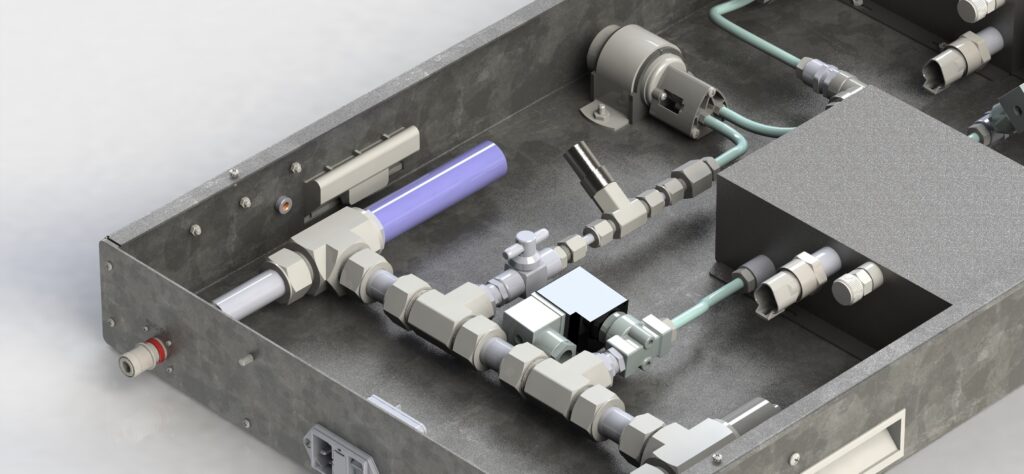
Our system will simultaneously monitor the pH of the systems coolant as well as the conductivity which will inform us of the water content of the coolant. These are the top two parameters that effect performance in a liquid cooled system. The CHMS will respond to any minor/major fluctuations associated with these parameters and correct the issue at hand, instantaneously. This allows the coolant circulating within the system to always stay at optimal health and provide proper performance throughout its lifetime. Instead of a service person responding to a coolant issue when the coolant has already dropped below optimal parameters, this system never allows the health of the coolant to deteriorate below acceptable levels ensuring no harm is done to equipment.
The CHMS is a compact, efficient, and cost-effective way to ensure no periods of extensive downtime occur to liquid cooled server rooms and data centers. Eliminating the need for in-person intervention, allowing for on the spot coolant adjustments, and ensuring no revenue is lost is top priority making this design of the CHMS the most effective solution possible on the market.
Validation
SolidWorks Model
Throughout the design process everything was modelled on SolidWorks, this allowed us to ensure physical size and connections of our components were accurate. With the intention to create a prototype, engineering drawings were created for the outer case, electronic shelf, three reservoirs and lid. Having the CAD and drawings developed will provide an excellent step for CoolIT to transition to the procurement and building of the CHMS.
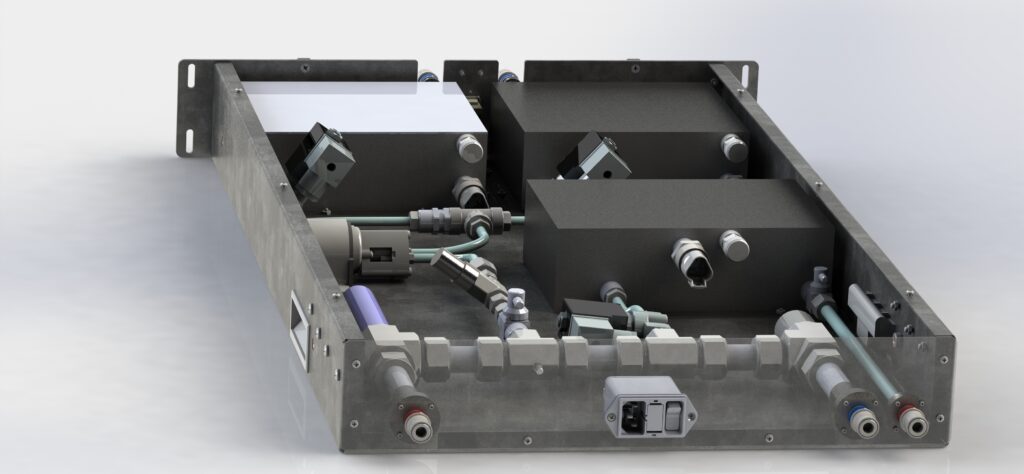
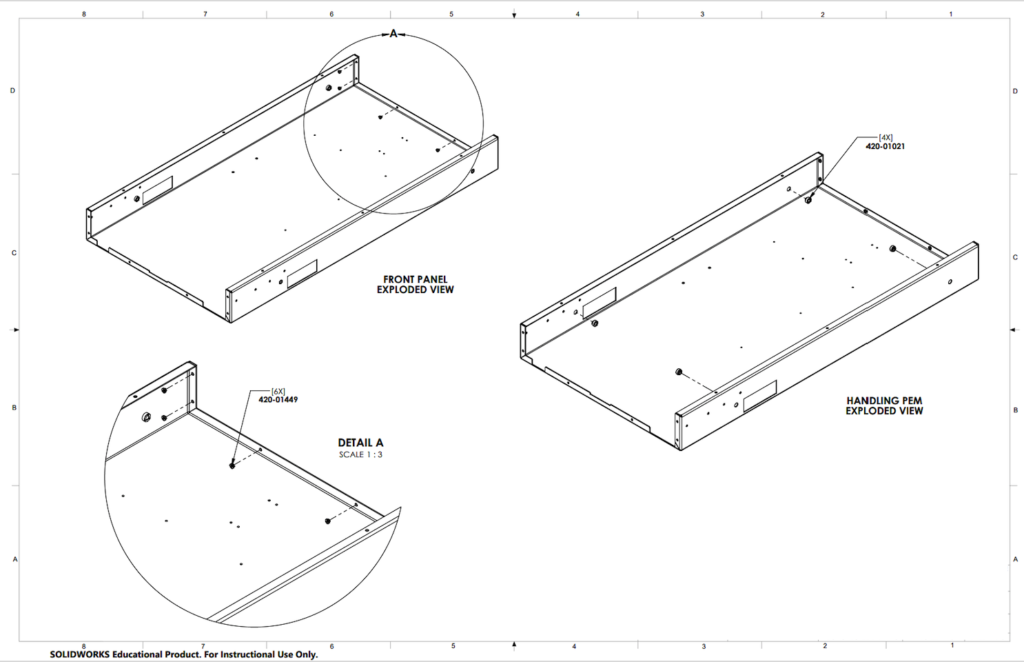
Calculations
Based of the pump flow rate of 1500mL/min at 30psi, calculations were performed in order to determine the amount of Coolant Extender or PG 15 we would need to add to the given system. The optimum pH of the system is between 7.6 and 9.5. While analyzing we assumed a pH of 8.5 and water conductivity of 2.08 uS/cm, the following shows a graph of how long our pump would need to engage for to inject the correct amount of Coolant Extender for a 30 litre system.

To determine the water content of the system, we used a conductivity sensor to determine when our propylene-glycol concentration increases. In the optimum system, there is PG25 present but as time goes by the water content decreases through water vapour transmission loss. In order to counter act the water vapour losses we add in a higher water content coolant (PG15). As shown below, the conductivity sensor will determine how much PG15 to add in a 30 litre system.
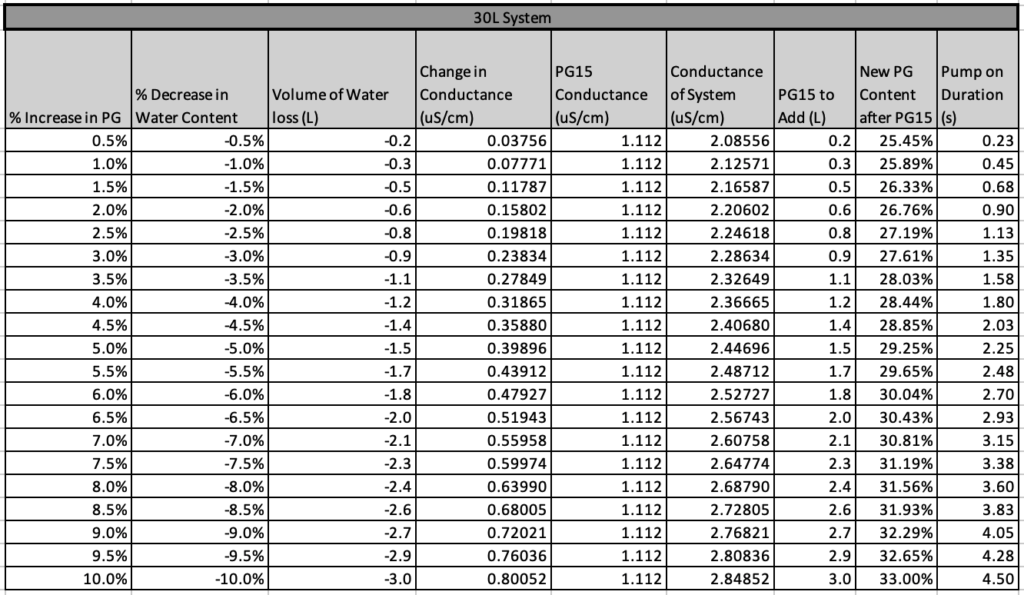
Feasibility
The teams goal was to design and develop a realistic Coolant Health Monitoring System that could be seamlessly incorporated into various CDU’s. To do this, there was multiple constraints and guidelines we had to follow, such as: physical size, power consumption, universal fittings, weight, cost and environmental factors. In order to meet all criteria we integrated as many off the shelf products as possible.
Once assembled the CHMS will be able to quickly connect into existing lines with the easy SCG03 connection fluid ports. The unit is also equipped with convenient handles ensuring that handling and installing of the product is efficient. This was designed to run in parallel with existing CDU’s therefore it is a universal fit in CoolIT server racks. The most costly portion of the CHMS will be the fabrication of the 3 custom reservoirs but will be discounted for a large production. Benefitting also to the user experience of our design, the unit features 2 LED lights for simple communication if it is working properly or needs repair. If there were to be an issue with the device then, the tech can simply plug into the unit via ethernet cable into the front of the unit. The Coolant Health Monitoring System was designed and developed to CoolIT’s product acceptance criteria and met all agreed expectations.
Partners and Mentors
We would like to thank Sebastian Varela and Vishal Mehmi from CoolIT for their guidance and support throughout this project. Our group would also like to thank our academic advisor, Dr. Roman Shor for his mentorship and both Dr. Arief Budiman and Saeedeh Saghlatoun for their advice and feedback.
Our photo gallery
